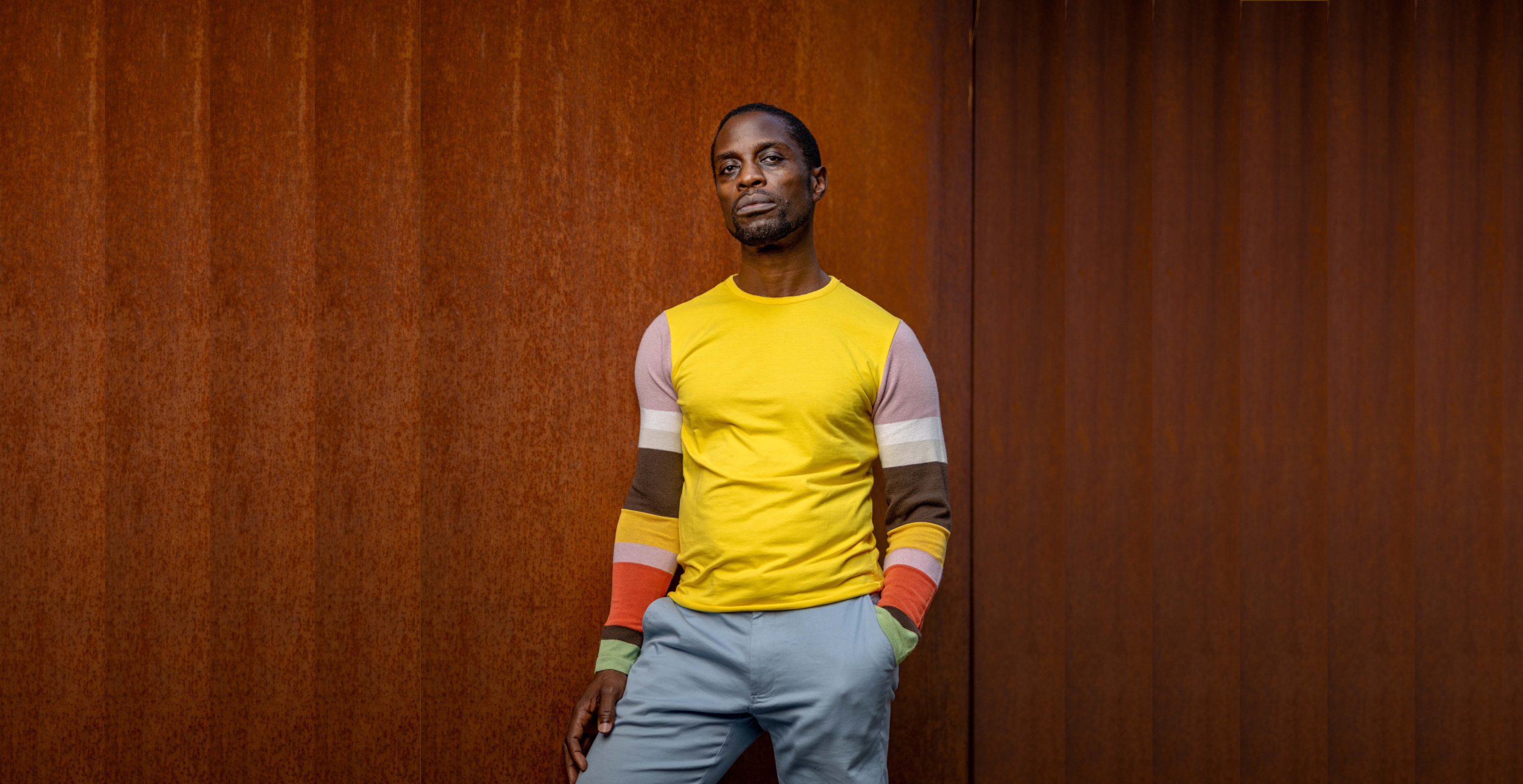
Press
PRESS
-

In Concert Street Dance, Everything Old Is New Again
Adesola Osakalumi, Ephrat Asherie and Michelle Dorrance hold forth on Hip-Hop, collaboration and what it means to bring street styles to the concern stage. By Caedra Scott-Flaherty
“I feel that Hip-Hop culture—dance, to be specific—is the most important and dynamic American artistic creation in the past 100 years,” Adesola Osakalumi told me a few hours before the opening night performance of his newest (and oldest) work. “It has impacted almost every other dance form. It’s given life to musical theater, it’s given life to film and it’s given ballet, modern and other western forms the understanding that there’s power in individuality.”
It’s a bold statement, but the evidence is there. New York City Center’s Fall for Dance Festival commissioned two world premieres for their 20th Anniversary Season, and both are deeply rooted in Hip Hop culture: Osakalumi’s JAM ON THE GROOVE 3 for 30.. -

THE JOURNEY FROM DANCER TO CHOREOGRAPHER
A PANEL DISCUSSION WITH MAYTE NATALIO, ADESOLA OSAKALUMI + ELLENORE SCOTT MODERATED.
BY DANI BARLOWDANI | Was there a specific show that you worked on where you thought, “Oh, this helped me become really clear on how I want to do my work,” or “This was not how I want to do my work, but I had to learn it in real time?” ADESOLA | I was fortunate enough to be cast in Equus [in 2008]; this was a time when I was like, “Oh, I’m not dancing anymore. I’m an actor. Don’t send me on dance auditions.” My manager, who is very wise, was like, “Sure. Sure, you are. So this is an audition you’re going to go on.” And I went, and I was fortunate enough to get the job. The choreographer was based in London, her name was Fin Walker. I didn’t know what her movement palette and her style was going to be, but when we got in the room for the audition, she was very nontraditional musical theatre…
-

TRUST. EMBRACE. RELEASE.
BY ADESOLA OSAKALUMI
Collaboration is the lifeblood of any good production. Not just in theatre but in life, in relationships, in navigating the New York City transit system, throwing a birthday party, driving over the George Washington Bridge, and more. Interestingly enough, all of these activities are elements of what it can feel like when creating work for a show. From my very earliest exposure to dance via the Egbe Omo Nago/Africa I Dance Theater in Brooklyn, I saw how creating dance truly takes a village. Those early experiences shaped the way I work and interact inside and outside of the rehearsal room.
Having a strong background in improvisational styles of movement has given me the freedom to always leave room for the dancer and actor to find what fits and allows them to fully embody what I am asking of them…. -

by Lauren Wingenroth
This Double-Billed Performer/Choreographer Is Bringing a Surprising Amount of Dance to Broadway’s Newest Play
You couldn’t be blamed if you showed up to Skeleton Crew, a play by Dominique Morisseau starring Phylicia Rashad that just opened on Broadway, not expecting any dance. Set in Detroit in 2008, the show, directed by Ruben Santiago-Hudson, follows a group of auto workers navigating the impending closure of their factory.
But not only does Skeleton Crew have dance, it opens with dance, and dance is the thread that weaves the fabric of the show together. The man doing the weaving: Bessie winner and Broadway veteran Adesola Osakalumi, who joins the elite ranks of artists (like Savion Glover and Tommy Tune) double-billed on Broadway as both performers and choreographers.
-

Broadway review by Adam Feldman
There is a touch of David Mamet in Skeleton Crew’s who’s-fooling-who intrigue about the company’s plans for the plant’s future (and a rash of robberies that seem like inside jobs), and a hint of August Wilson in the differing modes of Black masculinity embodied by Joshua Boone as Dez, a streetwise hustler with a suspicious backpack, and Brandon J. Dirden as his straight-laced foreman, Reggie. There is also a budding flirtation between Dez and Shanita, and even some break dancing in the breaks between scenes:
The self-choreographed Adesola Osakalumi, a holdover from director Ruben Santiago-Hudson’s powerful 2016 production of Skeleton Crew at the Atlantic, performs riveting robotic moves that evoke, among other things, the automation that is rendering human workers more dispensable.
-

by Helen Shaw
As a storytelling engine, Skeleton Crew glides along, with complications slotting neatly into revelations and a worker’s poetry lubricating the action. “I know everything about this place,” says Faye. “The walls talk to me. The dust on the floors write me messages.” Morisseau is the modern-day bard of Detroit — her other work includes Detroit ’67 and Paradise Blue — and those two plays treat some aspect of the city’s past specifically through its music. It takes a moment to realize she has written in the same key here, but instead of imagining Motown record parties or jazz-age trumpeters, she envisions a score of metal-stamping, piston-pumping, and whistle-blowing. During transitions, Santiago-Hudson has dancer Adesola Osakalumi pop and lock, playing a lyrical impression of the factory itself, his choreographic precision echoing the way a hydraulic press slams into position. There’s perhaps too little of that kind of music in the scenes, but it’s a welcome element between them.
-

by Ayanna Prescod
The majority of the first act is devoted to deliberate character development with scene changes led by fluid hip-hop dances by Adesola Osakalumi and stunning projections by Nicholas Hussong. At times you might wonder where it’s all going, but like the production line, every moment is judiciously planned and carefully assembled. Her characters move sequentially along a line that, in the end, gives life and nuance to working-class people often portrayed as one-dimensional. “Skeleton Crew” is more than a play about blue-collar blood and sweat; it is a story filled with depth and relatable characters. Morisseau gives you meat along with dem bones.
-

by GangStarr Girl
Adesola Osakalumi was born to be a star. The Bronx native developed an appreciation for theater by dancing at his family owned African dance company (Africa I Dance Theater) and when he hung out with friends, he immersed himself in b-boy culture. Eventually, he joined a group called the Rhythm Technicians, with whom he toured the country.
“We did an Off Broadway show called Jam on the Groove, which was the first theatrical presentation on a theater stage of hip-hop dance with using dance to tell stories as a vehicle for story telling..
-

by CLEM RICHARDSON
‘Fela!’ star Adesola Osakalumi has role connection to Nigerian musician, political activist. It was not exactly a debut when Brooklyn native and current Bronx resident Adesola Osakalumi took his star turn as "Fela!" at the Al Hirschfeld Theater.
"I've played Fela maybe 80, 90 times," said Osakalumi, who starred both in the hit musical's national touring company as well as understudied and alternated the lead role on Broadway. "I've played it a lot."
-

BY RICHARD JOHNSON
THERE is an oft-repeated saying, 'If a Jamaican is not involved, then it hasn't been invented'.This refers to the presence of Jamaicans in almost every sphere of life.
The achievements of second-generation Jamaicans in the world of the arts cannot be underestimated. Supermodels Naomi Campbell and Tyson Beckford, actors Sheryl Lee Ralph and Harry Belafonte and hip hop star Sean Kingston, have set the stage for many, who though born in foreign lands, still identify with their roots.
-

By Jeff Niesel
Destiny’s Child singer Michelle Williams might get top-billing in Fela!, the Broadway musical that arrived in town last night at the Palace Theatre for a three-night stand. But Adesola Osakalumi, who plays Fela Anikulapo-Kuti, deserves all the accolades. Osakalumi, who played Fela when the play was on Broadway, commands attention from the moment he arrives on stage.
-

By Chris Jones
If you set out to re-create the ambience of The Shrine, the feverishly infamous Lagos music venue ruled by the Nigerian icon, Afrobeat guru and political revolutionary Fela Anikulapo Kuti, let's just say that the cavernous Arie Crown Theater, in the mostly mothballed eastern end of McCormick Place, doesn't exactly rush to mind. Especially when that venue, presenting one of its very few public attractions in recent months, feels about 20 percent full.

